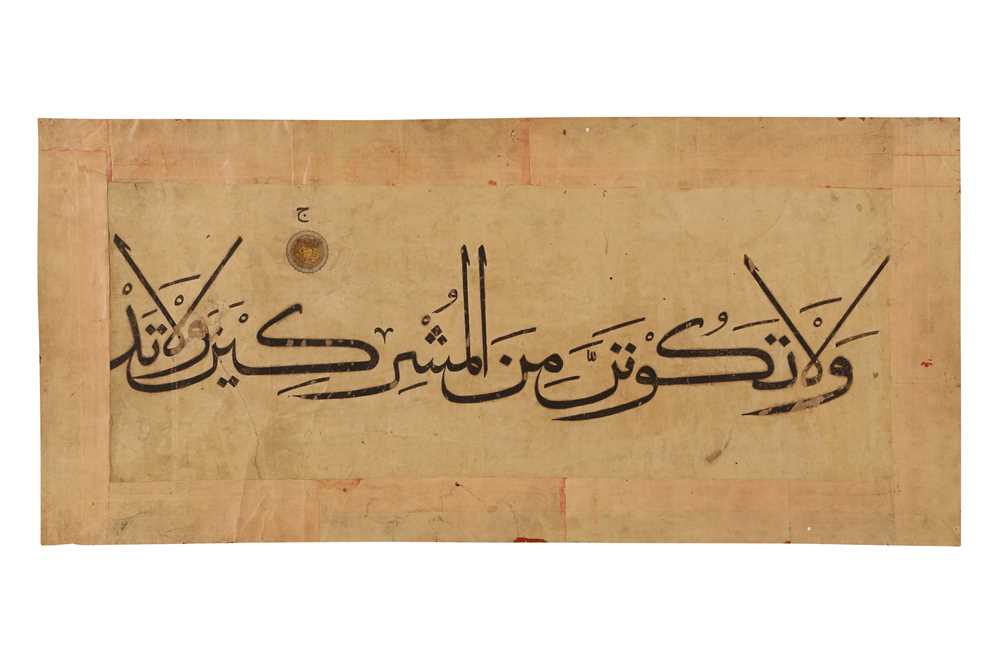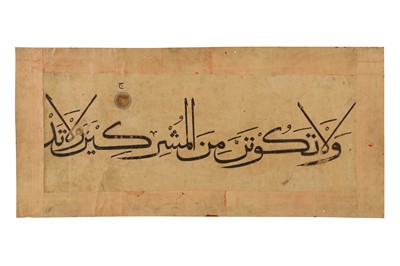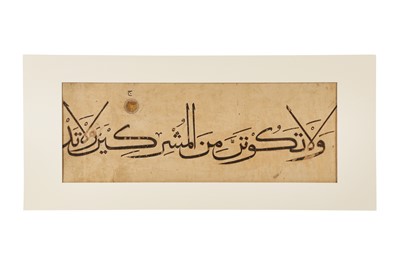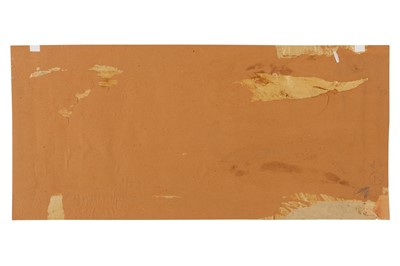28th Oct, 2022 11:00
Islamic Art - Property of a European Collector Part IV
A SINGLE LINE OF THE QUR’AN IN MONUMENTAL MUHAQQAQ SCRIPT
Qajar Iran, 19th century
A SINGLE LINE OF THE QUR’AN IN MONUMENTAL MUHAQQAQ SCRIPT
Qajar Iran, 19th century
Sura Yunus (10), parts of ayas 105 and 106, Arabic manuscript on paper in dark black ink, the design, calligraphic style, and letters' size reminiscent of the monumental 'Baysunghur Qur'an', possibly a Qajar replica, the verse marker designed as a concentric circular motif in gold on black, lined, with added plain margin, the length of the alif 13.6cm, the text panel 30cm x 80.2cm, 43cm x 94cm including the cardboard mount.
In the history of Islamic calligraphy and the arts of the book, the monumental 'Baysunghur Qur'an' remains one of the greatest achievements to date, an inimitable testimony of the precious link between Timurid royal patronage and the artist's quest to please and mesmerise his audience, reaching innovative and unexplored artistic heights. Although the name of the Timurid Shah Baysunghur (1397 - 1434), son of Shah Rukh (1377 - 1447) and grandson of Timur (1336 - 1405), has been historically linked to this magnificent example of monumental Qur'an in muhaqqaq script based on the contemporary assumption he authored the thuluth katiba inscriptions on the main gate of the Gowharshad Mosque in Mashhad, scholars now tend to believe that this massive tome (each folio measuring around 180cm in length and 105cm in width) was written by the famous calligrapher 'Umar Aqta under Timur's patronage. Since its creation, the manuscript rested on the marble Qur’an stand commissioned for Timur’s tomb by his grandson Ulugh Beg in the Bibi Khanum mosque in Samarkand. The reverie was broken by Samarkand’s fall to the invading army of Nadir Shah in the late 1730s. Nadir’s troops dismembered the manuscript and stole many of its leaves, which did little for their preservation. Around 60 folios were rescued and placed in the tomb of Shahzadah Ibrahim in Quchan, where the Scottish travel writer and artist James Baillie Fraser (1783 - 1856) reported seeing them in 1822, remarking their dilapidation.
In the Qajar era, Nasir al-Din Shah (1831 - 1896) recorded seeing the folios during his travels in Khorasan in 1882, describing them to be made of Khanbaliq paper, and impressive in size though damaged. He then ordered two of the folios to be sent to Tehran for restoration and display in the government museum. The original folios suffered further damage following the 1895 earthquake in Quchan, and were finally transferred to the shrine’s collection by Prince Muhammad Hashim Afshar in 1912.
The rediscovery of the folios, the mythical qualities of their production and dispersion, and the great Qajar king’s interest in them mark a pivotal point in the history of collecting. Size, as well as history, mattered to the late Qajars, especially given their tendency to revere Iran’s lost glory. The renewed interest and curiosity in the 'Baysunghur Qur'an' folios during the Qajar era sparked a vogue for replicas and heavy restoration of these precious pages. Made as tributes rather than forgeries, the Qajar folios, however, did not match the technical tour de force of the original. Unlike the precise and austere Timurid folios, Qajar examples are often composed of assembled paper fragments and some are embellished with clouds against a gold ground.
The present line may well be from a replacement and not a replicated folio. The calligrapher took care of respecting the same length of the alif as the original (13cm - 14cm), but he added a very slight inclination to it, possibly filling a gap and expressing his own hand, rather than merely copying an existing line. The lack of overly ornate Qajar embellishments, the closeness of the original paper’s chain-lines, and the even absorption of the ink mark this lot as a ponderous piece of calligraphic work. A collaboration across centuries, it is a testament to the endurance of the art form.
Sold for £1,750
Includes Buyer's Premium
Do you have an item similar to the item above? If so please click the link below to submit a free online valuation request through our website.



